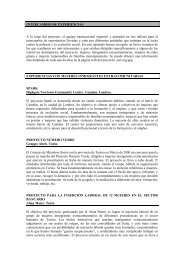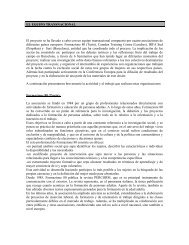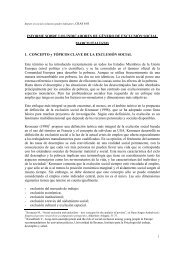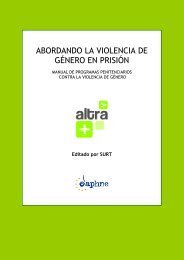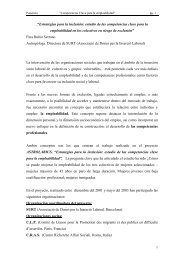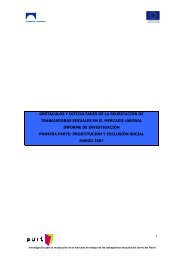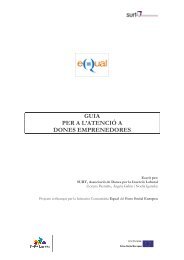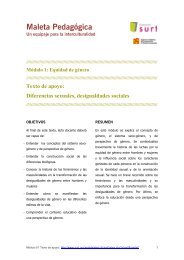THEORETICAL AND METHODOLOGICAL FRAMEWORK - Surt
THEORETICAL AND METHODOLOGICAL FRAMEWORK - Surt
THEORETICAL AND METHODOLOGICAL FRAMEWORK - Surt
You also want an ePaper? Increase the reach of your titles
YUMPU automatically turns print PDFs into web optimized ePapers that Google loves.
INDEXPREAMBLE.............................................................................................................. 3INTRODUCTION ..................................................................................................... 31. <strong>THEORETICAL</strong> <strong>FRAMEWORK</strong>...................................................................... 41.1. Social indicators as the framework of Gender Violence Effects Indicators. 51.2. Objectives of GVEI (Gender Violence Effects Indicators) ........................... 71.3. Concepts: Gender Violence, Violence Against Women and Gender ViolenceEffects .......................................................................................................................81.4. Which kinds of Gender Violence we will focus on...................................... 142. <strong>METHODOLOGICAL</strong> APPROACH.............................................................. 15A. In-depth interviews with women......................................................................... 162.1. Target group............................................................................................... 162.2 Sample and criteria for women’s selection ................................................ 162.3. Approach to and contact with women. Ethical issues. ............................... 182.4. Guide for the interview............................................................................... 19B. Focus groups with experts ................................................................................. 23GVEI. Theoretical and methodological framework
methodological proposal, by defining the process, structure and tools for the fieldworkand the focus groups. In particular, the methodological approach will deal with thefollowing issues:A. In-depth interviews with women- Target group- Sample and criteria of selection of women to be interviewed- Ways to contact and approach women and ethical issues- Guide for the women’s interviews: dimensions and variables.B. Focus groups1. <strong>THEORETICAL</strong> <strong>FRAMEWORK</strong>The feminist theories and the feminist movements have vehemently demonstrated thatknowledge cannot be considered neutral or objective. Traditionally, researchers haveengendered knowledge on the basis of the dominant perspective and behaviour insociety, which was the male one (androcentrism). As a consequence, knowledge hasbeen blind to the specific historical, political, social and personal conditions on which itwas reported, making invisible gender differences. Feminist epistemologies haveclaimed that knowledge is dynamic, relative and variable and that it cannot beconsidered an aim itself but a process.Taking into account this idea, the theoretical and methodological proposal of thisproject is based on the following principles:• gender inequalities and the promotion of women’s rights, interests and issues,are the common basis of the feminist studies and their epistemologicalconcerns, despite the fact that there multiple meanings of gender and theconcept of gender itself has been criticised (e.g. Butler, 2000; Breines, Connelland Eide, 2000);• violence against women “constitutes a violation of the rights and fundamentalfreedoms of women and impairs or nullifies their enjoyment of those rights andfreedoms” (Declaration on the Elimination of Violence against Women, UN,General Assembly Resolution 48/1004 of 20 December 2003);• there are many expressions of violence against women and new ones canappear according to the development of the social changes and the socialdynamics;GVEI. Theoretical and methodological framework 4
• violence against women has multiple and multidimensional effects, but all ofthem have the common denominator of being gender based;• from a feminist perspective, the best way to know something about violenceagainst women and its effects is by hearing the voices of the women that haveexperienced this phenomenon.1.1. Social indicators as the framework of Gender Violence EffectsIndicatorsAccording to Gabàs, “social indicators can be understood as quantitativemeasurements of a social phenomenon, its presence or its absence in the socialreality”. Indicators are quantitative data often presented as “statistical informationchosen specifically to shed light on a specific economic, demographic or socialproblem/question. Indicators can be a single figure or distribution; figures can beexpressed as numbers, percentages, rates or ratios” 3 . The challenge therefore, is tocapture qualitative information and to transfer it into quantitative indicators to givevisibility to a social phenomenon.In this way, social indicators can be useful tools in planning, policy-making, researchand general monitoring of social and living conditions. Stuart Rice 4 contended that“Social indicators are needed to find pathways through the maze of society’sinterconnections. They delineate social states, define social problems and trace socialtrends, which by social engineering may hopefully be guided towards social goalsformulated by social planning”. In our view, this definition gathers two core elements ofthe rationality and purpose of social indicators, which can be applied in GVEI project: Social indicators can have a descriptive function (description of social statesand of trends in social change), The analytical tools they can be for policy-making, planning and monitoring 5 .On the basis of the above conception, the resulting indicators of GVEI should seek todescribe and measure the multidimensional effects of GV in women’s life and, at thesame time, serve for future planning and policy-making for the design of integral policyresponses to this phenomenon and the women who suffer it.3HEDMAN, BIRGITTA, PERCUCCI, FRANCESCA, SUNDSTRÖM, PEHR, Engendering Statistics, a Toolfor Change. Statistics Sweden, 1996. Cited in EUROPEAN WOMEN’S LOBBY, Towards a commonEuropean Framework to monitor progress in combating violence against women. EWL, 2001.4 UNESCO (1974), “Social Indicators: problems of definition and of selection” in Reports and papers in thesocial sciences. No. 30.5 Idem.GVEI. Theoretical and methodological framework 5
There are several definitions, kinds and processes of measurement of social indicatorsthat here we will not explore. However, it is noteworthy pointing out the criteria that,according to experts, indicators should accomplish 6 . In particular, the desired indicatorsare those:Indicators that come from the theory used as the framework of the research andindicators that answer the objectives of the project.Indicators that are direct measures of the phenomenon analysed.Indicators of results (those indicators that inform about the stage of thephenomenon) and not indicators of means (that inform about the resourcesaddressed from society to the social phenomenon).Valid indicators, this means indicators that are not affected by “participantindicators” (other indicators that determine the selected ones).Indicators that can be integrated or disintegrated.Precise indicators and indicators that could be easily interpreted.The selection of indicators must not be determined by the existence ofstatistical data. In this sense, it could be useful to distinguish between “possibleindicators”, those indicators that can be calculated using the existing statisticaldata, and “desirable indicators”, those indicators that can not be calculatedbecause there are not available data.And, finally, experts recommend avoiding “redundant indicators”. The aimshould be to capture the maximum of information with the minimum indicators.Social analysts point out that social indicators are always approximate measurements.They are probabilistic measures that can never capture the phenomenon in all itsextent. In this way, as Gabàs 7 claims, we will design social indicators according to ourconceptualisation of a social phenomenon. Depending on the definition of thisphenomenon, on the dimensions we focus our attention on, and depending on thecharacteristics we use to describe it, we will design different indicators. This is thereason why a previous theoretical analysis of the social phenomenon is an essentialpart of the process of designing social indicators.Social phenomena can be differently conceptualised and each concept acceptsdifferent definitions. Therefore, methodological and theoretical choices will determine6 SURT, Gabàs, A. (2003) Methodological proposals for the design of social indicators, in the projectGENDER INDICATORS AGAINST SOCIAL EXCLUSION, Transnational Exchange Programme Phase Iand Phase II. Employment and Social Affairs. European Comisión (2002-2004).7 SURT, Gabàs, A. (2003) Methodological proposals for the design of social indicators, in the projectGENDER INDICATORS AGAINST SOCIAL EXCLUSION, Transnational Exchange Programme Phase Iand Phase II. Employment and Social Affairs. European Comisión (2002-2004).GVEI. Theoretical and methodological framework 6
the process of designing social indicators. This is why some authors consider thatbesides any system of indicators, there is a political and ideological approach comingfrom the theoretical framework selected 8 .On the basis of the methodology used in a previous SURT project of creating socialindicators (Gender Indicators Against Social Exclusion), we propose the followingmethodological process for GVEI:A definition of the objectives of the project: why we want to design a system ofgender violence effects indicators, which kind of applicability we are looking for,what do we want to reach, and so on;Conceptual and theoretical analysis of the phenomenon that we want toanalyse: establishing the theoretical framework that will be the basis of thesystem of indicators. For GVEI purposes, this implies to define carefully thetheoretical framework and the concepts of GV, VAW and GVEI, and to establisha list of the main dimensions of effects that will guide the new proposal ofindicators.Fieldwork: to recover the voice of the women suffering GV and to collectqualitative information about the effects of this particular form of violence.De-constructing concepts and creating new qualitative indicators according tothe results of the fieldwork.Transforming the qualitative information into quantitative indicators, so the realdesign of indicators as quantitative measurements of the effects of GVexperiences.Analysing the viability of the new indicators according to the existing data,distinguishing between “possible indicators” and “desirable indicators”.Launching recommendations of necessary basic data in order to be able toimplement GV effects indicators and design integral policy responses forwomen to the phenomenon.1.2. Objectives of GVEI (Gender Violence Effects Indicators)This project aims to design GV effects indicators for measuring and shedding light onthe multidimensional effects of GV in women’s life. The rationality behind the indicatorsis:8CARRASCO, CRISTINA; DOMÍNGUEZ, MARIUS. Nous indicadors de treball i gènere. Una propostametodològica (New labour and gender indicators. A methodological proposal. Barcelona societat/12.Revista d’informació i estudis socials (Review of information and social studies). Ajuntament de Barcelona.2003.GVEI. Theoretical and methodological framework 7
to make visible and measure the effects of GV episodes in multiple spheres ofwomen’s life that usually remain invisible (beyond health consequences,dimensions such as labour, family, social networks, participation in the publicsphere, housing, etc. will be explored). Previous research projects have shownthat the fact of suffering GV has a holistic effect in the sense that becomes atransversal factor affecting women in all spheres of life. The indicators,therefore, at first stage will seek to shed light and measure these multipleeffects.to provide information and data with a view to design comprehensive policyresponses to help and empower women suffering GV.to improve social policies to combat GV.1.3. Concepts: Gender Violence, Violence Against Women and GenderViolence EffectsThere are many ways to name violence against women. Terms such as “domesticviolence”, “male violence”, “sexist violence” and “domestic violence against women” areusually used to conceptualise this kind of violence, but their meanings may be different.The Fourth World Women’s Conference, celebrated in Beijing in 1995, has describedviolence against women (VAW) as a social subject that consists in “any act ofviolence based on gender, which may result or actually results in physical, sexual orpsychological harm, including threats, coercion or arbitrary deprivation of liberty, ineither private or public life” 9 .Thus, VAW can be considered gender based violence, understanding gender as theset of roles, rights, representations, expectations and values assigned to each sex; thissocio-cultural construction of what is feminine and masculine places men and womenin different positions in society, establishing power relationships among them andlocating women in an inferior and less valued situation. In this way, gender “refers tothe social organisation of the relationship between the sexes and to the fundamentallysocial quality of the distinction” 10 .As Russo and Pirlott 11 state, in “Western society, gender is typically organised aroundthe social categories of male versus female and assigned at birth on biological sex”. In9 Platform for action. Item 113 - Fourth World Women’s Conference.10 Sunnari V., Kangasvuo, J. And Heikkinen, M. (2002), Gendered and Sexualised Violence in EducationalEnvironments. Oulu. 2003.11 Russo, N and Pirlott, A. “Gender-Based violence. Concepts, methods and findings” in Annals New YorkAcademy of Sciences, 1087, p. 178-205, 2006.GVEI. Theoretical and methodological framework 8
this way, “gender defines the appropriateness of behavioural, psychological and socialcharacteristics of males and females over the life cycle, and shapes the way weconstrue ourselves” 12 . Thus, children, through the process of socialisation, interiorisethe roles associated to their sex, behave as expected and reproduce the divisionbetween genders, which places women in a position of subordination, less power,recognition and resources than men. In our patriarchal society, masculinity is usuallyassociated with power, domination and control over women and, as McHugh argues,“violence is one means by which men can perform masculinity” 13 as well; this maletrend traditionally has been legitimised and seen as natural. Hence, this dominantmodel inevitably shapes the way children grow up and construct themselves.Therefore, we understand that, as Godenzi claims, “men’s violence against women isboth a means and an expression of the conditions of inequality between men andwomen” 14 . In other words, VAW needs to be understood as “a manifestation of thehistorically unequal power relations between men and women, which have led todomination over and discrimination against women by men and to the prevention ofwomen’s full advancement” 15 . This gender based violence is perpetuated againstwomen for the sole reason of being women 16 .VAW, therefore, can be considered as the main expression of gender violence,understanding that GV is a broader concept because it can cover any type of violence(usually against women but not solely) as a consequence of the aforementionedgender relationships and unequal distribution of power between genders. For thisproject purpose, therefore, when talking about GV we will refer to gender-basedviolence perpetrated against women, which is constituted by:“any kind of violence addressed against women as a representation of discriminationand inequality, framed in an ancient and structural system of power of relationshipsbetween men and women, that is expressed in any sphere of life (private or public)throughout economic, physical or psychological harms, including threats, intimidationsor coactions, which may result or actually result in physical, sexual or psychologicalinjury or suffering 17 .12 Cross and Masden, 1998. Cited in Russo, N and Pirlott, A. “Gender-Based violence. Concepts, methodsand findings” in Annals New York Academy of Sciences, 1087, p. 178-205, 2006.13 Anderson and Umberson, 2001. Cited in Understanding gender and Intimate Partner Abuse, McHugh,M. Sex Roles, vol. 52, n 11/12, June 2005.14 Godenzi A., in Breines, I.; Connell, R; Eide, I, (eds). Male Roles and Masculinities: A Culture of PeacePerspective. UNESCO, 2000, Paris.15 Platform for action. Item 118 - Fourth World Women’s Conference. 199516 This concept is also recovered by the Spanish Integral Law Against Gender Violence, Organic Law1/2004, of 28 September.17 Platform for action. Item 118 - Fourth World Women’s Conference. 1995GVEI. Theoretical and methodological framework 9
We believe that “gender roles and expectations, male entitlement, sexualobjectification, and discrepancies in power and status have legitimised, renderedinvisible, sexualised, and helped to perpetuate violence against women” 18 . Majorinstitutions also reinforce and perpetuate these entitlements and inequalities, which areat the roots of gender violence. This violence, therefore, may take place in any sphereof life. In other words, gender inequalities are reproduced at home, in the labour marketand the workplace, in education, etc.The two main focuses of GVEI will be GV perpetrated by men in intimate partnerrelationships, which is one of the most known manifestations of GV, although till lastdecades it has been considered (and it is already considered so in many countries) aprivate problem; and GV experienced in the workplace. The situation of inequality ofwomen in the labour market is visible and recognised in most Western societies; this isalso a consequence of gender division and unbalanced relations of power betweengenders. Thus, the sexual division of work and patriarchal values reinforce andmaintain this women’s disadvantage situation, which in many cases, leads to genderdiscrimination and violence against them. GV in the workplace can be shaped by threeaxis, three dimensions of a same problem: VAW, where violence is understood as atool of gender power; a sexist labour context that is based and reproduces multiplediscriminations against women (a more cultural and invisible dimension); and a contextof abuse of power; of gender and, many times, of hierarchy 19 .This situation of inequitable gender relationships is visible in all spheres of life, such asbetween female workers and male employers, wives and husbands, female athletesand male coaches, etc. and maintains the legitimacy of male violence 20 . As a result, thereality is that women and girls experience gender based violence over the lifespan, inhomes, schools, churches, workplaces, public spaces and therapeutic settings 21 .Kelly 22 carried out a research in the UK where she found out that most womenexperience sexual violence in their lifetime. She uses the concept of continuum ofviolence to refer, on the one hand, to the fact that the common character in sexualviolence is that men use a variety of forms of abuse, coercion and force in order tocontrol women. And, on the other hand, to the continuous elements that pass into oneanother and cannot be distinguished, which constitute a range of abuses, coercionsand force that women experience. Kelly argues that this last meaning serves to explain18 Russo, N and Pirlott, A. “Gender-Based violence. Concepts, methods and findings” in Annals New YorkAcademy of Sciences, 1087, p. 178-205, 2006.19 Instituto de la Mujer (2006), El acoso sexual de las mujeres en el ámbito laboral. Estudios einvestigaciones. MTAS.20 Russo, N and Pirlott, A. “Gender-Based violence. Concepts, methods and findings” in Annals New YorkAcademy of Sciences, 1087, p. 178-205, 2006.21 Idem.22 Kelly L. "Continuum of sexual violence", in Hamner, J. & Maynard, M. (eds.) 1987, Women, violenceand social control. Explorations in Sociology 23. MacMillan, London.GVEI. Theoretical and methodological framework 10
that depending on how women subjectively define the experiences they have, theseexperiences will fall into or out of a given category like, for instance, sexualharassment. She stresses that continuum of violence underlines the fact that “sexualviolence exists in most women’s lives, whilst the form it takes, how women defineevents and its impact on them at time and over time varies”. In this way, continuum ofviolence also refers to the fact that within the wide range of abuses that women mightexperience, the more common and everyday forms might be considered part of malebehaviour and, as a consequence, women might not define these as abusive.The idea of continuum of violence goes in line with our understanding of genderconstruction and, in this sense, it is interesting to keep it in mind for two main reasons.On the one hand, because it recovers the idea stressed earlier that women, for the solereason of being women, are exposed to male violence throughout the whole lifespanand they can receive violence in all spheres of life.On the other hand, continuum of violence also refers to the continuous of abuses thatpass into one another, from the more common to the more extreme. In this continuum,the more common and everyday abuses might be interiorised by women, as aconsequence of the social and cultural transmission of gender roles, expectations andentitlements, as natural. Women, therefore, might not recognise these abuses andtolerate them. Furthermore, continuum of violence also relates to the fact that abusesare not isolated facts but part of a process. The definition of abuse for a womanchanges among women and also might change over time.Within this perspective, women for the sole reason of being women are exposed tovarious forms of gender violence all over their life. A position paper of the EuropeanWomen’s Lobby reflects this idea stating that “Violence against women is a continuum,a concept that refers to a continuous series of physical, verbal and sexual assaultscommitted by men on women, encompassing sexual violence and includes “anyphysical, visual, verbal or sexual act that is experienced by the woman or girl, at thetime or later, as a threat, invasion or assault, that has the effect of hurting her ordegrading her and/or takes away her ability to control intimate contact” 23 .In the present project, we will keep this perspective as a broad framework and,although we will put our attention on women who recognise that they have experiencedgender violence in the partner relationship or/and in the workplace, we might find outthat they have suffered violence in other spheres of life.23 European Women’s Lobby (EWL) Violence against women - an obstacle to equality of women and men.http://www.womenlobby.org/site/1abstract.asp?DocID=702&v1ID=&RevID=&namePage=&pageParent=&DocID_sousmenu=GVEI. Theoretical and methodological framework 11
Conceptualisation of GV effectsThis project starts from the hypothesis that GV has multiple and multidimensionaleffects for women’s life. In other words, suffering such a brutal phenomenon hasconsequences at diverse spheres of women’s life like health, labour, family and socialrelations, housing, social and political participation, affective relationships, etc. Thus,GV has an unquestionable impact in the quality of life of women, reducing theircapacities of development and well-being, and impeding women to live in safety. AsCarrasco 24 argues, the lack of safety implies that women are not able to live in freedomand welfare, to enjoy the fullness of rights and to have possibilities of access to an ownproject of life. In this way, we hold that GV becomes a mainstream factor crossing andaffecting all dimensions of women’s life, undermining women's personal and socialwell-being, deteriorating their quality of life and increasing their vulnerability in a societywhere women are already in a situation of inequality respect men.According to this perspective, GV may become an impoverishment factor, understoodin a wide sense, that’s it, as a factor of social exclusion. Thus, understanding thatsocial exclusion is a dynamic and multidimensional process that impede a person toenjoy of individual autonomy and rights to participate fully to social, communitarian,economic, educative, labour,… spheres of life, we can affirm that GV, since it affects allthese dimensions and deteriorates the capacities of women, can push women towardssocial exclusion or poverty.Therefore, GVEI project will analyse the effects that GV has in 9 dimensions ofwomen’s life by recovering the experiences of women who have suffered GV. Theanalysis of these effects will be done from a gender perspective.On the basis of the information collected, GV effects indicators will be designed, with aview to capture and measure the extent of these multidimensional effects. Theseindicators will also alert of the risks of social exclusion for women suffering GV.Taking into account SURT experience of working with women suffering GV and theprevious researches being done on the effects of GV, the dimensions of women’s lifethat will be explored in the present project are the following: Health Housing Legal Economic Labour Children24 Carrasco, C. (2006) Estadístiques sota sospita. Proposta de nous indicadors des de l’esperiènciafemenina. Institut Català de les Dones. Barcelona.GVEI. Theoretical and methodological framework 12
Social relationshipsRelations with men in generalIntimate relationshipsHowever, new dimensions remaining invisible so far different from the ones abovemight arise from the fieldwork with women.Main expressions of Gender ViolenceAmong the several expressions of gender violence 25 , and in an illustrative way, weremark the following:- Physical violence: intentional or negligent action or omission against thewoman’s body which may result or actually results in physical injury.- Psychological violence: any kind of intentional action or omission, as threats,humiliations, vexations, exigencies of obedience or submission, verbalcoercion, verbal abuse, isolation, stalking, deprivation or limitation of liberty, thatmay result or actually results in psychological suffering, harm or self-esteemdismissing.- Sexual harassment, sexual violence or sexual abuses against women: includingexhibition, surveillance or any behaviour of sexual nature imposed to thewomen without her consent, throughout violence, intimidation, emotionalmanipulation, forced sexual relationships, stalking, etc. and with independenceof the relationship between the victim and the offender.- Economic violence: intentional or non justifiable deprivation or limitation ofeconomical resources of the woman or her family, that may result or actuallyresults in physical or psychological damages, injuries or sufferings on thewoman or her children 26 .Main spheres of life affected by Gender ViolenceGV is also a phenomenon that takes place in all spheres of life. With the provision thatwe are talking about some expressions of this kind of violence (see footnote 7), weremark the following:- Partner relationship context: it includes physical, psychological, sexual or/andeconomic violence against the woman, caused by her partner or her ex-partner,as well as by a person who has or has had a similar relationship with thewoman.25 We have expressly dropped out of this example other forms of violence against women, such as theviolence perpetrated or tolerated by the Government or their agents or officials, or the violation of thewomen’s human rights within armed conflicts circumstances, among others, because these kinds ofviolence against women remain out of the limit and the scope of the GVEI project.26 These expressions of violence against women are also recovered by the Draft bill of the “Law on theWomen Rights for the Elimination of Male Violence” (Catalan Government, January 2006).GVEI. Theoretical and methodological framework 13
- Family context: it includes physical, psychological, sexual or/and economicviolence against the woman or/and her children, caused by the members of thefamily (apart from the partner, which is included at the concept above), andwhich is conditioned by the affective and emotional family relationships.- Workplace context: it includes physical, psychological, economic or sexualviolence that usually, but not solely, adopts the form of the so called “sexualharassment” or “sexual based harassment”. We define “sexual harassment” asany undesirably behaviour of sexual nature (including verbal abuse,gesticulations, physical actions), with the purpose of attempting to the dignity ofone person, throughout the creation of an intimidating, hostile, degrading,humiliating, offensive or disturbing environment. On the other hand, weunderstand “sexual based harassment” as a situation where a person issuffering an undesirably behaviour in relation with her sex, in her work orvocational training, with the purpose of attempting her dignity, and throughoutthe creation of an intimidating, hostile, degrading, humiliating, offensive ordisturbing environment.- Social or community context: it includes physical, psychological or sexualviolence against women, like sexual aggressions (rape and any other sexualaggression in which sex is the weapon to demonstrate the power of the menover women), sexual harassment, forced marriage, genital mutilation, sexualslavery, trafficking in women, crimes against sexual and reproductive rights, etc.- Any other kind of violence against women based on gender with the purpose ofattempting their dignity, integrity or freedom.1.4. Which kinds of Gender Violence we will focus onTaking into account, on the one hand, the nature and characteristics of GVEI projectand, on the other hand, the complexity of the phenomenon of GV, in this project we willfocus on two kinds of GV:• GV in the intimate partner context: understood as physical, psychological,sexual and/or economic abuse 27 of a woman by her male partner or expartner(s)or by another person who has or has had a similar relationship withher.• GV in the workplace context: understood as any kind of discrimination or violentact (physical, psychological, economic or sexual violence) targeting women thattakes place in the workplace context and that is based on gender. Thus,27 The definitions of physical, psychological, sexual and economic abuse are the ones referred earlier.GVEI. Theoretical and methodological framework 14
violence and discrimination are used as mechanisms of gender power againstwomen, who are in a position of inequality respect men, in an sphere thattraditionally has been a male domain. It may include, among others, sexualharassment 28 , wages discrimination, mobbing, discrimination for maternity, etc.In GVEI we will focus on GV acts taking place under the umbrella of labourrelations (that is, between employer-employee or employee-employee) andperpetrated by men.2. <strong>METHODOLOGICAL</strong> APPROACHThe methodological approach for GVEI is based on qualitative research methods. Inthis sense, the research techniques are thought to capture the subjective experiencesof women who have suffered GV and, in particular, the effects that GV has had onwomen themselves and their lives. The focus of our research, therefore, is themultidimensional effects of GV for women’s lives. On the basis of the encounteredeffects, we will build indicators to measure them.As mentioned earlier, this approach is based on the perspective of Women’s Studies,which aims to challenge the dominant forms of research, which are andocentric, biasedand blind to gender differences and, therefore, are unable to understand social realityas a whole 29 . Thus, the use of qualitative and participative methodologies will allow usto re-construct concepts and pay attention to new ones not attended so far, with a viewto move forward on the analysis of a phenomenon that has its roots in gender relationsand roles.Qualitative and participative methodologies will allow us to recover the voice of the realactors of the phenomenon studied, women who have suffered GV. Thus, women’sexperiences will alert about the limits in the existing concepts and indicators andprovide information on the factors that we need to consider in order to design GVeffects indicators.The research techniques to be used are the following:A. In-depth interviews with women who have suffered GV in the partner contextand in the workplace sphere.B. Focus groups with experts.28 See definition in the previous page.29 Espinar Ruiz, E. (2006) Violencia de género y procesos de empobrecimiento. Córdoba. Servicios depublicaciones de la Universidad de Córdoba.GVEI. Theoretical and methodological framework 15
By using qualitative methodologies, as it is the case of GVEI, the potential value of theselected interviewees is more important than the concrete number of interviews. In thissense, the current research does not aim to be representative but to search for qualityand to provide an in-depth insight on the effects of GV in the partner context and in theworkplace for women. For this reason, interviewees have to be selected consideringrelevant categories in relation with the subject of the study. However, certain degree offlexibility is assumed.Following, some guidelines to carry out the fieldwork and select the interviewees will bedetailed.A. In-depth interviews with womenIn-depth interviews can be defined as “face to face meetings between the interviewerand the interviewee addressed to the understanding of the interviewee’s perspectivesin relation with their lives, experiences or situations, according to their own words” 30.The interview is thought to create a room for a dialogue between interviewee andinterviewer, but where the real actor is the interviewee.Thus, interviewed women will have freedom to stress the important issues, raise newones, voice their experiences, etc. In this way, this technique will allow us to collectcomprehensive information and to understand women’s experience on the effects thatGV brought about in their lives.2.1. Target groupThe target group of GVEI research is constituted by:- Women in the age of majority; according to the United Nations Convention onthe Rights of the Child (1990), a child is any person under the age of 18 and,therefore, we will focus on women who are at least 18 years old.- Women who have suffered GV in the partner context and/or women who havesuffered GV in the workplace sphere.2.2 Sample and criteria for women’s selectionThe sample of GVEI project will be constituted of: 15 women in each country (in total,60). The distribution will be the following:30 TAYLOR, S.J. and BODGAN, R., Introducción a los métodos cualitativos de investigación. Barcelona,Paidós, 1992.GVEI. Theoretical and methodological framework 16
- Spain and Estonia: 8 women who have suffered GV in the partner context and 7women who have suffered GV in the workplace.- Finland and Italy: 7 women who have suffered GV in the partner context and 8women who have suffered GV in the workplace.The criteria for women’s selection will be:- Nationality: considering the current migration flows to the EU, the diversityinherent to our society and the fact that migrant women are even moreunprotected and vulnerable to suffer GV, it is important to incorporate migrantwomen in the sample. In many countries, statistics on DV state that migrantwomen suffer DV to a greater extent than autochthonous women. For GVEI,however, we will try to include migrant women in a proportional way to theirpresence in general society. At least, there should be a migrant women in eachof the two groups (GV in partner context and in workplace)- Ethnic group: at least one woman of an ethnic group not majority in society ineach of the two groups should be included. If more ethnic groups can beincluded, excellent.- Age: 5 women in each of the following age groups: 18-30, 31-45, and +45years old.- Expressions of violence (physical, psychological, sexual and economic):for the women who have suffered GV in partner context, a woman of each caseshould be included. For the women who have suffered GV in the workplace, atleast a woman experiencing psychological violence, a woman suffering sexualviolence and a woman suffering economic violence should be included. For thecase of physical violence in the workplace, as it might be very difficult to find awoman experiencing it, it will not be a required criteria but a desirable one. Weare aware, however, that in some cases (above all in the partner context) theseexpressions of violence might take place in a combined way whereas in othercases they might take place individually.- Economic sector for GV in the workplace: considering that the realities of theterritories of the 4 countries might be a bit different, our proposal is to consider3 broad economic sectors: services, industry and education. Each partner canadapt the sample to the State reality but at least women working in 2 of theseeconomic sectors should be included. Women working in feminised sub-sectorswill be incorporated in the sample.- Labour relations: for the selection of the women suffering GV in the workplace,we will concentrate on all the relations that take place under the umbrella oflabour relations. Therefore, we will choose women having experienced GV thathas occurred between employer-employee and employee-employee.GVEI. Theoretical and methodological framework 17
2.3. Approach to and contact with women. Ethical issues.Each partner will develop its own strategy and use its own networks to approach andcontact the women participating in the fieldwork. However, following we will give someindications for the process of reaching, contacting and interviewing our target group.The contact of women will be done trough entities/organisations. Thus, women willbe reached by means of:- Women’s Institutes The general criteria for- Women’s associations for contacting these- Shelter houses organisations is that they- Support groups are sensitive to gender- Trade Unions and do not victimise- Lawyers offices the womenAs a research coherent with the feminist epistemology, the rights and respect of thewomen will be guaranteed throughout the research process. In this sense, womenwill participate voluntarily and will set the conditions for carrying out the interview(e.g. the place). The interviewer will promote a safe environment and will actwithout victimising the women. The safety of the women is the most important and,in this sense, we should of course provide water, juice and seat. Besides, weshould be supportive and let them stop if they need it.The technique to be used is the in-depth interview. An interview guide withdimensions that should be explored within the interview will be facilitated.Interviews will be recorded and transcribed.Confidentiality and anonymity will be guaranteed. As the interviews will berecorded, each country will apply the State norms related to the protection ofpersonal data.The interviewer will have in mind, and work according to, the aims of the researchand the basic guide of the interview.Flexibility will be a key in the development of the interviews: it means thatsometimes it will be necessary to set up more than one meeting with the woman,others a second one will not be needed, time of the interviews may be variable, etc.Each partner will write a letter to send to the entities and, following, to the women,informing about the research framework (Daphne project, partners involved, etc.),aims and expected results. The letter will also state that research will respectanonymity and confidentiality of data.When possible, the results of the project will be given to the entities and the womenparticipating in the fieldwork.GVEI. Theoretical and methodological framework 18
Taking into account that the methodological process will be quite flexible and adaptedto the national realities, once the sample selection will be done and the focus groupswill be formed, each national team will elaborate a brief document on the methodology,outlining those particularities of their selection process as well their own methodologicalprocess (ways followed to contact women, composition of the sample, period ofinterviews, ethnic groups and nationalities included, etc.). This information will begathered by SURT and added to the present document, “Theoretical andMethodological Framework”.2.4. Guide for the interviewThe concrete form of in-depth interviews to be used in GVEI project is the semidirectedinterview. This form is a half way between open and closed interviews. In thiscase, the researcher has a list of topics to guide the interview and her role will be tofocus the interview on the expected subjects.Thus, the guide presented in this section includes the dimensions that should becovered during the interview. It has been elaborated on the basis of SURT’sexperience in working with women suffering GV and the secondary research carriedout during the first phase of the project.As it is a qualitative research, each interview will take its own pace and development,since the woman will be the real protagonist. However, the interviewer should bear inmind that all these dimensions should be tackled. It might happen, as mentioned, thatothers initially not foreseen raise.For achieving the aim of the in-depth interview and guaranteeing the stress on theinterviewee, it is important not to start the interview with very directed questions, whichwould imply that the interviewer defines the relevant information, but with suggestinggeneral questions allowing the interviewee to talk about what they consider importantand relevant. Once the interviewer has information about the general context oninterviewee’s life, she/he can focus on concrete subjects or asking more directedquestions 31 .The guide of the interview presented below has the aim of orientating the interviewer,clarifying and taking care that the aims of the research will be maintained. As Gabàs 32claims, it is a support tool and it never has to be considered as a strict questionnaire. It31SURT, Gabàs, A. (2004) Theoretical and metjodological framework, in the project GENDERINDICATORS AGAINST SOCIAL EXCLUSION, Transnational Exchange Programme Phase I and PhaseII. Employment and Social Affairs. European Comisión (2002-2004).32 Ídem.GVEI. Theoretical and methodological framework 19
is based on a thematic list, collecting a map of the general areas that the researcherwants to cover in the interview. The interviewer will decide how to ask the questionsand when to ask the interviewees for them during the interview.The dimensions/variables to be explored are the following:1) Health: this dimension covers both physical, sexual/reproductive andpsychological effects of GV for the women. Thus, it should be explore the healthstate of the woman as a consequence of the GV experience; not only shorttermeffects (immediately after the experience of violence) but also whenpossible (if the experience of violence took place some time ago), long-termeffects of violence.Some illustrative examples of potential effects are:- Physical:i. headache, buzzing in the ears, earache,ii. muscular contractions or muscular pains; fracturesiii. internal or external bleedingiv. cerebral commotionv. wounds, bruises, bullet wound, burns, cutsvi. anaemia, blackoutvii. tiredness or chronic fatigue- Psychological:i. alimentary disordersii. feeling of becoming crazyiii. Sleep disordersiv. PTSDv. Depressionvi. Sadness, fears, anxiety, anguishvii. Loss of self-esteem, loss of confidenceviii. Auto-blaming- Sexual/reproductive:i. miscarriageii. Sexually transmitted diseaseiii. Non desirable pregnancies2) Housing: this variable consider the effects that GV has had on women in termsof housing. Some potential issues are:GVEI. Theoretical and methodological framework 20
- Need to run away from home or to move as a consequence of theconflicts- Loss of the house- Difficulties to pay the rent or mortgage- Troubles to find home- Need to go to a shelter house3) Legal: this dimension deals with the legal process that can be associated to GVand some women might go through. Some potential elements to consider are:- Reporting of the facts to the police- Presenting formal accusation at the Court- Bringing the case to trial and verdict resulting- Partner compliance of the sentence and effects to the woman- Protection measures taken, during the proceeding or as a consequenceof the sentence- Legal assistance available during the proceeding- Feeling of safety and protection during the proceeding- Trust in the legal system4) Economic: this dimension refers to the economic effects that the experience ofGV might have had for the women. Some issues can be:- Economic autonomy or dependence- Loss of the control of her economy or finances- Economic damages as a consequence of the violent incidents- Need to ask for economic or financial help- Economic losses (money but also car, jewelry and others)- Institutional dependence5) Labour: this dimension deals with the consequences that GV has had forwomen in the labour sphere, both if she had a job during the experience and ifshe did not.- Employed women:i. Absenteeismii. Lack of punctualityiii. Economic sanctions, disciplinary measures or any otherpunishment, like to lose the job or to be removed of her jobposition as a consequence of the unpunctuality and absenteeismresulting from GV experienceiv. Problems of concentration or efficiency at workv. Disabilities as a consequence of GV experiencevi. Sick leavesGVEI. Theoretical and methodological framework 21
vii. Sexual harassmentviii. Threats of being firedix. Threats of losing the job position or the job statusx. Threats of salary or income reductionsxi. Problems of relationships with colleaguesxii. Need to quit the jobxiii. Fear to go to workxiv. Isolation in the workplacexv. Possibilities of voicing the situations and effects on her job andsituation- Non-employed women (before or as a consequence of the GVexperience):i. Difficulties to find a job as a consequence of her physical orpsychological stateii. Rejection of job opportunitiesiii. Access to vocational training6) Children: this dimension deals with the effects that GV has on women withrelation to her children. As the aim of this project is to examine the effects thatGV has for women, despite being aware that GV has direct effects to children,here we will deal with the effects for the women related to children. In thissense, some areas to be explored are:- Custody- Care of the children- Economic responsibilities- If the woman is the sole responsible for taking care of the children:i. Economic difficultiesii. Difficulties in work-life balance- Difficulties in bringing up the children due to her psychological state7) Social relationships: this dimension focuses on the effects that GV might haveon the social sphere for women. Some elements that can raise are:- Loss of friends and social relations- Social/familiar isolation- Distrust in people- Relationships questioned (family/friends)- Feeling of being questioned by family, friends- Difficulties to communicate and mix with people- Difficulties in ordinary conflict resolutionGVEI. Theoretical and methodological framework 22
- Troubles to ask for help- Lack of the sense of pertinence- Decrease on the participation in community organisation, volunteeractivities, political or religious organisations, etc.8) Relations with men in general: this dimension explores whether GVexperience has had an impact on women in terms of establishing socialrelationships with men. Some elements that could be explored are:- Consideration of men in general- Ability to communicate with men- Fears of men in general9) Intimate relationships: this dimension deals with the effects that GV mighthave had on women regarding potential intimate relationships. This dimensionmight include issues such as:- Ability to have and maintain an affective relationship- Attitude towards sexual relationships- Experience of sexual relationships: absence of orgasm, pain, not sexualappetite- Fear of having a new intimate relationshipB. Focus groups with expertsThe fieldwork of GVEI also foresees the realisation of 3 focus groups with experts. Theaim of these focus groups is to provide supplementary information to the one facilitatedby women and to bring about a deeper insight to the effects of GV from theprofessional expertise and experience of working with women or researching on thisissue. In this way, below there are 3 proposals on the composition of the three focusgroups:1) Mixed focus groups: One focus group multidisciplinary, gathering experts from the legal field,psychology, anthropology, etc., both from the academic field, public institutions,trade unions,… and the area of intervention with women suffering GV. One focus group gathering psychologists who intervene with women sufferingGV, by carrying out individual or group support sessions to women, bysupporting women in their process of labour insertion, etc.GVEI. Theoretical and methodological framework 23
One focus group gathering professionals offering integral support services towomen suffering GV such as social workers, professionals working in shelterhouses, etc.2) Separate focus groups: to carry out one/two focus group targeting experts andprofessionals working with GV in intimate relationships and another one/two withexperts and professionals working with GV in the workplace.3) 2 focus groups and individual interviews with professionals/experts: if any partnercannot carry out 3 focus groups, another possible option is to conduct 2 focus groupsplus some individual interviews with experts/professionals. This option would allowthose partners who need it to solve agenda problems or to obtain specific informationon those aspects that have not been covered sufficiently in the previous focus groups.As long as each partner justifies and explains her methodological choice, it is enough.Both the composition and the conduction of the focus groups are thought to be flexible.In this sense, we suggest that each partner will be able to conduct the focus groups onher own way (without a previous guide), just keeping in mind that the focus of theresearch is to analyse the multidimensional effects of GV, and the aim of thesediscussion meetings is, therefore, to provide a complementary insight to these effectsfrom the view of the experts.The facilitator should lead the course of the discussion, suggesting items, questions,etc. but in a flexible way. The aim is to collect information on the effects of GV in thedifferent dimensions considered (or if new ones come out, then, in the new ones aswell), so the facilitator can lead the discussion having this goal in mind.The items for discussion will be proposed orally (using a support like a powerpointpresentation if needed). It is important to not give much information in order to notinfluence the participant. As the idea is to go in depth into the effects of GV in eachdimension, a way to facilitate the discussion would be to start focusing on eachdimension and exploring the effects that GV has in each of them, according to theexperts.A proposed number of people for a focus group could be between 4-7 people.GVEI. Theoretical and methodological framework 24



